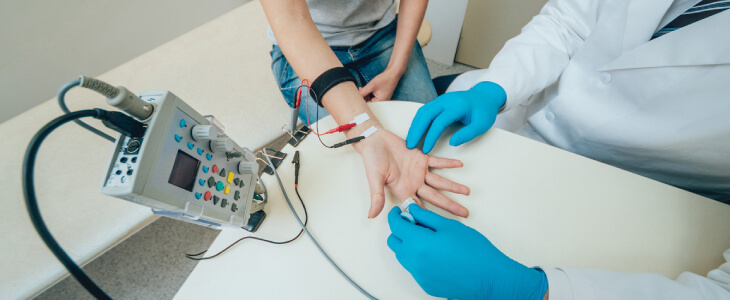If you have not been through an EMG (electromyography) study before, you may be wondering what to expect. At Long Island Spine Rehabilitation Medicine, our doctors are committed to partnering with you when it comes to your healthcare, so this blog is designed to clarify what an EMG study is, why it is administered, how to prepare for it, how it will feel, and what it is designed to diagnose.
First of all, be reassured: an EMG is a safe and benign procedure with no aftereffects. It is a useful tool for our physiatrists in determining whether you have a neuromuscular condition that accounts for your symptoms and, if so, to provide an accurate diagnosis so that we can offer you the correct treatment.
Why Our Doctor Wants You to Have an EMG
EMG studies are recommended for patients exhibiting symptoms that may indicate a neuromuscular disorder. The symptoms that brought you to our door may include:
- Tingling
- Numbness
- Muscle weakness of fatigue
- Muscle pain, cramping or spasms
- Pain in your limbs
- Problems with mobility
We provide numerous therapies for nerve and muscle conditions, both traditional and complementary. We have ordered an EMG so that we can accurately decode the reason for your symptoms and provide you with the most effective treatments.
How Should I Prepare for an EMG Study?
Preparation for an EMG study is not complicated. It simply involves:
- Wear loose, comfortable clothing that is easy to adjust or remove. Depending on which part of your body is being tested, you may be asked to wear a hospital gown.
- Keep your skin free of lotions or oils on the day of your test since they might interfere with the electrode sensors.
- Turning off any electronic devices (e.g. cell phones) to prevent interference
- Informing your doctor of all medications and supplements (especially muscle relaxants or blood-thinning drugs) you are currently taking, as well as all pertinent facts of your medical history (e.g. previous or familial nerve or muscular disorders, the presence of a cardiac defibrillator or pacemaker.
Don’t worry that you will forget to mention one of these important matters; we will remind you and ask you relevant questions before administering the test.
What Conditions Can an EMG Diagnose?
EMG studies are instrumental in diagnosing a broad range of conditions affecting the nerves and muscles, including:
- Carpal tunnel syndrome
- Sciatica
- Peripheral neuropathy
- Other pinched nerves
- Herniated spinal disc or other back problems
- Amyotrophic lateral sclerosis (ALS)
How Does It Feel To Have an EMG Study?
During the EMG, you may experience slight discomfort when the needles are inserted. As the electrical activity detected by these needles is displayed on a monitor, you may hear audio feedback during the test. When performed properly and by our experienced team, any associated discomfort should be minimal.
There are two parts to an EMG study:
- Nerve conduction during which the doctor will put electrodes on your skin to measure the speed and strength of transmitted electrical signals.
- Needle EMG during which small needle electrodes will be inserted into targeted muscles to record electrical activity.
To get feedback during muscle contraction, you will be asked to contract and release muscles during the exam. At times, you will also be asked to change positions. Unless you have been sedated, you will be able to resume your normal activities as soon as the EMG study is completed.
The Takeaway
Having an EMG study is a minor procedure that will help us accurately diagnose any problem with your nerves or muscles. When you come to Long Island Spine Rehabilitation Medicine for this test, you can rest assured that you are being treated by highly skilled professionals whose primary goal is keeping you safe and comfortable, not only during this exam but throughout future treatment. Contact one of our five offices today.
